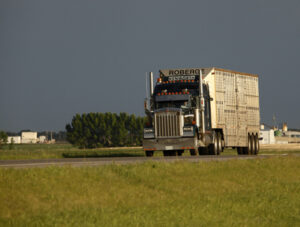On the Road Again
This article written by Dr. Reynold Bergen, BCRC Science Director, originally appeared in the March 2021 issue of Canadian Cattlemen magazine and is reprinted on the BCRC Blog with permission of the publisher.

The Canadian Food Inspection Agency (CFIA) announced significant changes to Canada’s livestock transportation regulations in 2019. Previously, truckers could haul cattle for 48 hours before a mandatory five-hour feed, water and rest stop (unless they were within four hours of their final destination). The new regulations require an eight-hour feed, water and rest stop after 36 hours, with no four-hour grace period. The new regulations could have benefitted from some meaningful science.
Research that could have helped inform these regulations has been underway since 2018. Karen Schwartzkopf-Genswein and Daniela Melendez Suarez of Agriculture Canada’s Lethbridge Research Station are leading a major study to determine whether feed, water and rest stops provide measurable benefits to feeder cattle during long-distance transport. The January 2020 research column described their first experiment, which found that rest stops didn’t clearly benefit preconditioned cattle. Their second experiment is now published (Effects of conditioning, source and rest on indicators of stress in beef cattle transported by road; doi.org/10.1371/journal.pone.0244854).
What They Did:
320 commercial steer calves (540 lbs) from one ranch were split into two groups. Half of them were weaned, vaccinated, given antibiotic treatment and parasite treatments and adapted to a backgrounding diet three weeks before the study started. The other 160 calves were not weaned until the transportation study started. These preconditioned and non-preconditioned groups were then split into two subgroups of 80 calves. One subgroup went to an auction mart overnight (with feed and water) and ran through the ring the next day. The “ranch direct” subgroup did not. Then commercial truckers hauled all the calves for 36 hours and unloaded them. At this point, half the calves were immediately reloaded and hauled for another four hours. The other half without rest were rested for eight hours, then reloaded and hauled the last four hours to the research feedlot.
Individual weights, rectal temperatures, blood samples and behavior measurements were collected before the initial loading, when they were unloaded after 36 hours, at the end of the rest period, after the final unloading, and 1, 2, 3, 5, 14 and 28 days after the transport ended. Blood samples were analyzed for physiological signs of stress, muscle damage and fatigue, dehydration, energy deficit, inflammation, trauma, infection, and immune responsiveness. Animal health and performance was tracked for four weeks.
What They Learned:
The results were highly complicated, because they measured a lot of things, and how a group of calves responded to transport or a rest stop depended on whether they had been preconditioned or not, as well as whether they had come directly from the ranch or through an auction mart. But here are the high-level results.
Ranch Direct vs. Auction Mart didn’t affect animal physiology, behavior, feed intake, growth or health in any meaningful way. Your results may vary! Unlike most calves arriving at commercial feedlots, the calves in this study were not comingled with calves from other ranches at the auction mart or during transport. This auction mart also provided feed and water, which may not always be the case.
Preconditioning vs. freshly weaned: Preconditioned calves were measurably more alert, more active, spent more time feeding, and had lower physiological measures of stress, muscle damage, fat breakdown, trauma, inflammation, had better immune function, ate more and grew better than non-preconditioned calves. Preconditioning did not affect treatment or death rates, possibly because all the calves originated from the same ranch.
Rest stops provided no clear benefits. For example, after the final unloading at the research feedlot, the calves that had a rest stop were less alert and more sluggish than the unrested calves. Unrested calves also spent more time standing on the day they arrived at the research feedlot. Was the rest stop actually restful, or did it make them more restless?
For every other measurement, the effects of the rest stop mainly depended on whether the calves had been preconditioned or not. For example, the energy status of all groups of calves was the same after the first 36 hours of transport. But at the end of the rest stop, the non-preconditioned calves had a significantly lower energy status than the preconditioned calves. Feed intake measurements indicated that the non-preconditioned calves ate less during the rest stop than the preconditioned calves did, particularly early in the rest stop. This may explain why the energy status of the non-preconditioned calves continued to worsen during the rest stop. Regardless, all groups of calves had recovered their energy status within a day after their final unloading at the research feedlot, and there were no differences in treatment or death rates associated with rest stops.
So What … Does This Mean to Me?
Rest stops did not provide any clear, across-the-board benefits for all groups of calves and might pose extra challenges to non-preconditioned calves. The team is currently studying whether an eight-hour rest after 36 hours benefits calves that travel another 12 hours to their final destination.
Preconditioning helped calves travel better. The BCRC has a calculator to help you decide whether preconditioning makes economic sense in your situation (www.beefresearch.ca/preconditioning/).
Click here to subscribe to the BCRC Blog and receive email notifications when new content is posted.
The sharing or reprinting of BCRC Blog articles is typically welcome and encouraged, however this article requires permission of the original publisher.
We welcome your questions, comments and suggestions. Contact us directly or generate public discussion by posting your thoughts below.